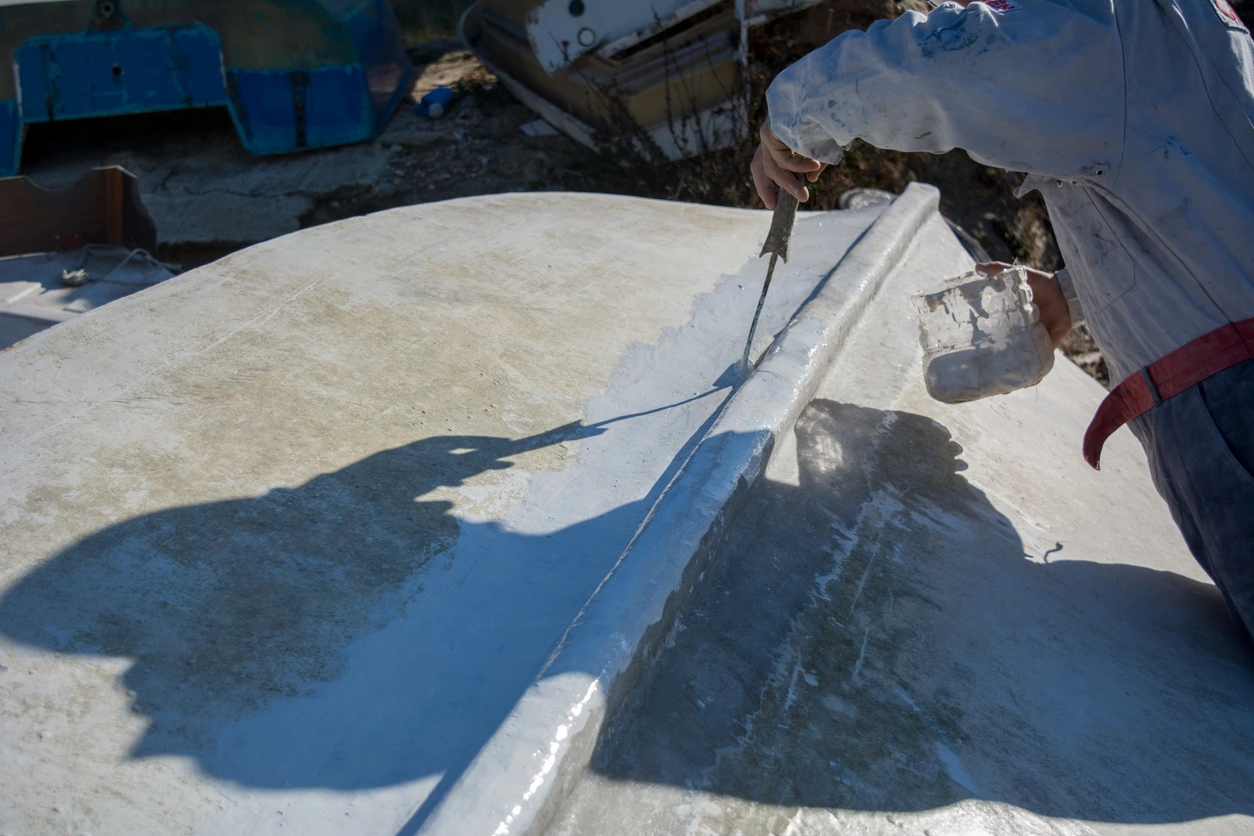What is boat osmosis? Guide to causes, treatment & prevention
14 November 2025

The term ‘boat osmosis’ can be daunting for boat owners. However, it may not be as worrying as you think.
In this guide, we explain what boat osmosis is and share how to fix it. We’ll highlight some boat osmosis risk factors, bust several common myths, and answer your frequently asked questions.
What is boat osmosis?
Boat osmosis is a type of blistering and degradation that occurs in GRP boat hulls when water penetrates the gelcoat. Over time, that water leaks into the laminate beneath and reacts with unreacted chemicals or water-soluble residues trapped during the boat’s manufacture. This creates acidic fluids and gases, which produce pressure pockets that cause blisters on the hull's surface.
When boat osmosis occurs, small blisters or bubbles appear on the underwater sections of the hull and, when punctured, these may release an acidic fluid. If left untreated, these blisters can deepen, negatively impacting the hull’s structure and causing many issues, such as increased drag, decreased resale value, and potentially costly repairs.
How to fix osmosis in boats
Professional osmosis treatment involves:
- Stripping the gelcoat and removing the affected laminate
- Thoroughly drying the hull, which can take months
- Applying new epoxy barrier coats and antifouling paint
Learn how to repaint a fibreglass boat in our guide.
Boat osmosis risk factors
There are several boat osmosis risk factors to be mindful of:
Poor quality hull construction or materials
- Poor-quality resins are more permeable to water
- Inadequate curing during manufacture
- Insufficient or uneven gelcoat thickness
Boat age
- Older hulls are more susceptible to boat osmosis
- Well-built hulls will eventually absorb moisture after decades on the water
Environmental conditions
- Warm water temperatures can accelerate boat osmosis
- Continuous immersion increases exposure to water
Maintenance & damage
- Scratches and cracks that breach the gelcoat
- Poor-quality repairs or coatings
- Improper antifouling removal
Storage
- Poor ventilation or humid storage conditions which prevent hulls from drying
- Inadequate drying before applying barrier coatings
Fancy an adventure in your boat once it's repaired? Read our guide to solo sailing here.
Boat osmosis myths
Boat osmosis is surrounded by some myths and misunderstandings that can cause confusion among boat owners. Here are some of the most common osmosis myths and the truth behind them.
1. Osmosis only happens in old boats
While older boats are more likely to show blisters, osmosis can happen to new boats too. This is especially true if the laminate quality or barrier coat is poor, or if moisture finds its way into the hull due to contamination during construction.
2. Every blister is disastrous
Small, isolated blisters are often purely cosmetic, especially if they don’t go deep into the laminate. Serious osmosis involves structural issues. For example, when water penetrates the laminate layers and causes hydrolysis of the resin. Many boats live long lives with a few small blisters.
3. Osmosis is caused by poor maintenance
Maintenance can have an impact on how osmosis develops, but it’s typically caused by chemical and manufacturing factors, not how often you wash or wax your boat.
4. Drying the hull in the sun will fix osmosis
Unfortunately, simply drying out a blistered hull in the sun won’t fix osmosis. This can evaporate surface moisture, but the underlying chemical reaction may continue unless the laminate is cleaned and resealed with proper epoxy barrier coats.
5. Blisters are caused by water leaking into the hull
Osmosis isn’t when water leaks in through cracks, it’s a diffusion process that involves water molecules migrating through the semi-permeable gelcoat due to concentration differences, not because of holes or leaks.
6. Epoxy coatings completely prevent osmosis
Epoxy barrier coats greatly reduce water permeability, but they won’t make a hull 100% waterproof. Over time, small imperfections or minor damage to the hull can still allow slow water ingress, regardless of whether it has the perfect epoxy barrier.
7. Boats with osmosis are worthless
Many boats that have undergone professional osmosis treatments perform just as well, and sell for almost as much, as unaffected ones, especially if the repair is documented and done properly. If you’re selling a boat with osmosis blisters, you should be mindful that it won’t be as valuable.
8. Boat osmosis spreads quickly
Osmosis is usually a slow process, and blisters can take years to develop. Panicking and organising expensive repairs is not usually necessary unless survey results show deeper structural issues.
Boat osmosis FAQs
Can osmosis sink a boat?
Boat osmosis won’t make a hull porous enough to let in large amounts of water like a crack or hole would, however, it can cause layers to delaminate or weaken which may impact the strength of the hull over time. It can also cause weak spots which could crack if put under extreme pressure, like grounding, and could cause leaks.
Essentially, osmosis won’t directly sink your boat, but severe, untreated osmosis can weaken the hull to a point where another failure might.
Can boat osmosis be prevented?
There are several ways in which you can lower the risk of boat osmosis, including regularly inspecting the hull below the waterline, using marine-grade barrier coatings to prevent water penetration, and keeping your boat dry when not in use.
Want to get your yacht ship shape? Here's the best yacht varnishes on the market.
Should I buy a boat with osmosis?
Blisters caused by boat osmosis are often just cosmetic, but they can indicate structural issues if water has reached and degraded the laminate. While small blisters are manageable, especially if the boat is otherwise in excellent condition and priced accordingly, large or widespread blisters can be potentially expensive to repair.
If you’re unsure, get a marine survey done by a qualified surveyor who can identify if the osmosis is cosmetic or structural. If the boat is otherwise great, you may be able to use the osmosis as leverage to negotiate a reduced price. Consider repair costs and any downtime that might be required if you can’t use the boat during osmosis treatment.
Specialist boat insurance through Craftinsure
While you’re wondering about boat osmosis and discovering how to best care for your vessel, you may also want to consider getting specialist boat insurance.
Specialist boat insurance through Craftinsure can help provide financial protection against damage and the theft of your boat, equipment and outboard motors, as well as up to 30 days of European cover. Get a quick online quote here.
Please note the information provided on this page should not be taken as advice and has been written as a matter of opinion. For more on insurance cover and policy wording, see our homepage.


